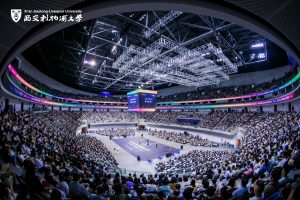2022-03-14
3:00 PM - 4:00 PM
Details
Time: 15:00
Date: March 14th, 2022
Format: Online broadcasting
Venue: https://www.learningmall.cn/mod/bigbluebuttonbn/vi... (BBB link)
Lecturer: Dr. Steffen Duhm
Title: Interface Physics and Chemistry of Dopant-free Hybrid Silicon Heterocontacts
Abstract
Dopant-free heterocontacts are frequently utilized as charge-carrier selective contacts of hybrid silicon solar cells with hiah power conversion etticiencies, Althouah these interfaces are well characterized from a device perspective, the physics and chemistry of contact formation mechanisms are still not well understood. We use X-ray photoelectron spectroscopy (XPS) to track core-level shifts upon contact formation and accessing the built-in potential. Furthermore, vacuum-level shifts are measured by ultraviolet photoelectron spectroscopy (UPS). By spin-coating ultrathin layers of the conducting polymer PEDOT:PSS on hydrogen-terminated n-Si we can track the Si core-levels upon contact formation and get direct evidence for inversion laver formation. In adition, our XPS and UPS data allows us to speculate that PEDOT passivates Si surface states. Furthermore, we demonstrate that the built-in potential measured with XPS correlates well with the open-circuit voltage of model solar cells. The same holds for devices with dopant-free MoOx/n-Si or LiF/p-Si heterocontacts as main building blocks. Strikingly, the insulator LiF forms a Schottky contact with p-Si and facilitates an ohmic contact in n-Si.
References
[1]R.-B.Wang, Y.-S.Wang, C.Wu, T.-S. Zhai, J.-C.Yang,B.-Q.Sun, S.Duhm and N.Koch, Adv. Funct. Mater. 30 (2020), 1903440
[2] S.-S. Wan,G.-H.Zhang,J. Niederhausen, D.Wu,Q.Wang,B.-Q.Sun,T. Song and S. Duhm, Appl. Phys. Lett. 118(2021),241601
[3]D.Wu, S.-S.Wan, T.-S.Zhai,J.-C.Yang, R.-B.Wang and S.Duhm, Phys. Status Solidi RRL16 (2022), 2100434
Speaker
Steffen Duhm obtained his Dipl.-Phys. (2004) and Dr. rer. nat. (2008) from the Department of Physics of Humboldt University Berlin, Germany. After that he became a JSPS Fellow at the Graduate School of Advanced Integration Science at Chiba University, Japan. In 2012 he became professor at Institute of Functional Nano & Soft Materials (FUNSOM) of Soochow Universitv. His work is focused on elucidating contact formation at functional interfaces using photoelectron spectroscopy. He has and h-index of 41 and more than 100 publications in peer-reviewed iournals including Nature Materials, Advanced Materials, Nature Chemistry, Physical Review Letters and ACS Nano.







